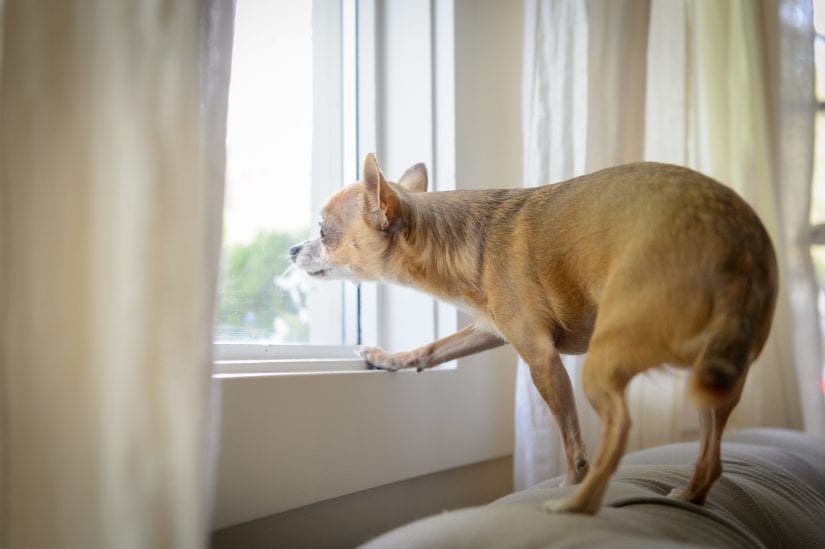It’s a common scenario. A dog owner returns home from work to find their favourite chair reduced to a pile of stuffing, an unpleasant stain on the carpet and a frantic dog circling at the door. Cases of separation anxiety – also known as separation distress – are surprisingly common and may be an unintended consequence of our busy lifestyles, with a growing number of single-person homes, pet owners working long hours and dogs being left alone to cope for lengthy periods of time.
“Dealing with chewed furniture and other damage is frustrating but it’s important to remember that your dog is not trying to punish you for leaving or acting out of spite,” says Dr. Karen van Haaften, the BC SPCA’s senior manager of behaviour and welfare. “If a behaviour is troubling for you, it’s probably even more troubling for your pet. The key is to have empathy and to understand what they are experiencing so you can find solutions to help them.”

Dr. van Haaften notes that dogs can suffer from different kinds of anxiety – triggered by certain noises or specific situations such as car rides or nail trims. Dogs can also suffer from more generalized anxiety in which there are multiple triggers for anxiety. “Some dogs are more prone to anxiety due to genetic factors or lack of socialization during their sensitive socialization period of six to 16 weeks,” she says.
Signs of anxiety are specific to the individual dog, but can include panting, excessive yawning, restlessness, inability to pay attention, repetitive behaviours, shaking, loss of appetite, or extreme attention-seeking behaviours. In some dogs, anxiety is manifested by social withdrawal, avoidance behaviours, or a profound lack of behaviour (‘shut-down’ behaviour).
If your dog shows signs of anxiety, says Dr. van Haaften, the first step should be to rule out underlying medical causes. “Your pet may not be suffering from anxiety, but may have a medical condition that is causing pain or distress,” she says. “Several studies in recent years have found a link between anxiety conditions such as noise phobia and painful conditions such as arthritis. Once you have ruled out a medical cause for the symptoms, observe your dog closely to identify their specific anxiety triggers so that you can begin to address them.”
1. Environmental Management
One way to reduce your dog’s anxiety is to minimize their exposure to the situations or triggers that cause distress. BC SPCA staff member Laura Barren has taken steps to address her dog Lacey’s noise aversion to fireworks. “Lacey has severe panic attacks when she hears fireworks in our Surrey neighbourhood,” says Barren. “She shakes uncontrollably and paces non-stop – it’s impossible to calm her.”
Living in an urban setting, Barren was unable to prevent Lacey’s exposure to fireworks at home, so she and her family plan camping get-aways on key holidays such as Halloween, New Year’s Eve and Canada Day to ensure Lacey will be in a fireworks-free zone.
“If you can’t remove your dog completely from the situation, try to lessen the exposure,” advises Dr. van Haaften. “If your dog is afraid of thunder, for example, keep them in a quiet room – ideally an internal room without windows, with soothing music playing and distractions such as their favourite treats and toys.”
For dogs suffering from separation anxiety, she adds, daycare, dog-walkers and other pet-sitting services may be a solution to avoid stressful departures.
2. Treatment
Training can be helpful to teach your dog a different (positive) emotional response to their triggers. This type of training is called desensitization and counter-conditioning, and essentially involves finding a level of the trigger your dog can tolerate and repeatedly pairing exposure with a something positive (treats, play, attention).
For example, a dog that is scared of car rides could spend a few minutes at the beginning and end of every week walking around the parked car. There is no pressure to get in the car, just games with their favourite tug toy and a few treats. Watch your dog carefully for a change in body language and behaviour when they start to learn that the previously scary trigger actually now predicts wonderful experiences.
When they are noticeably less fearful, you can try to increase the intensity of the trigger. “With the car phobia example, you could start by opening a car door, then get in the car with the dog, then the guardian gets in the front seat, then turn on the engine. Monitoring your dog’s body language is important – if at any point they start displaying signs of anxiety, return to a level they can tolerate and put in more repetitions.
Dr. van Haaften says desensitization and counter-conditioning can take time and patience, but the effort is worth it to help your dog cope. Depending on your dog’s personality, anxiety triggers and history, there are other approaches that may work better. If you need help designing a behaviour plan for your dog, we recommend contacting an AnimalKind Accredited dog trainer for assistance.
3. Supplements and Medication
There are several nutritional supplements and medication options to help your dog cope with stressful situations. “Supplements and medications can be used for occasional situations, like trips to the groomer or veterinarian, or on-going support for generalized anxiety,” says Dr. van Haaften. “Every dog is different and it is important to discuss your pet’s specific needs with a veterinarian.”
More tips
How do I welcome a new dog into my home?
5 Ways to keep your dog entertained at home

